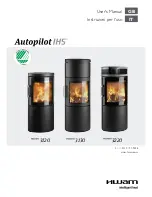
The distance between the stove external surface
,
flue
and
wall
should be at least:
n
for unprotected constructions of combustible and fire-resistant materials
- 500 mm;
n
for constructions
of non-combustible materials - 380 mm;
n
for constructions
? ?
of combustible
and
fire-resistant materials protected in accordance with clause 7.2 -
380 mm
;
Never install the stove in the corridor (passage
), or about a flight of stairs, it may hamper
passage
in ca
se of fire.
Do not install the stove
in the bedroom. Do not place the stove in a recess in the wall (a niche), or in the
fire place
(or
in
the
stone stove)
.
During the use of the stove, the stove pipe shall be treated very carefully.
Stove pipe (chimney stack) – is the means of air ventilation of exhausted gases, it provides the draught that
facilitates the constant air intake into the heating equipment necessary for normal burning process. The stove is
designed only for operation with natural draught.
The stove shall have its own stove pipe.
ATTENTION! It is prohibited to connect the stove to any air ducts except for the cases when the air duct is
designed only for operation as the stove pipe.
ATTENTION! It is prohibited to connect the stove to the stove pipe that is connected to another equipment
or heating unit.
ATTENTION! The stove does not draw. The draught is made only with the stove pipe.
The stove pipe has two functions for the stove trouble-free operation. The first – is the piping of exhaust gases
generating during the fuel combustion. The second – is draught for air intake into the fire chamber for combustion
maintenance.
Draught – is the natural air or gases movement through the stove pipe. It generates due to the feature of warm
air to go upwards.
As far as the warm air moves in the stove pipe the low pressure is generated in the place of the stove
connection to the stove pipe. The greater pressure from the outside of the stove makes the air move into the area of
lower pressure – into the area of fire box. Thus the air intake into the fire chamber happens. This constant air inflow
is the draught.
The stove won't be operating effectively if there is no draught of the definite value.
The optimal draught for operation of stoves of «Termofor» trademark equals to 12±2 Pa.
Provided the excessive draught the considerable air flow will be entering the fire chamber and this will lead to
the stove overheating. Fire hazard may appear.
With the insufficient draught the insufficient amount of air for fuel proper and complete combustion will be
entering the fire chamber and this may lead to smoke generation in the room. The creosote generation increases
upon the formation of excessive smoke in the stove pipe and that may ignite creating the fire hazard in a house.
Creosote — is colourless (sometimes yellowish or yellow-green), inflammable, hardly soluble in water oily
liquid with strong smell and pungent taste extracted from wood and coal tar. This is the mixture of phenols mainly
guaiacol and cresols. Soluble in alcohol and ether. Poisonous.
Creosote will inevitably be generated in your stove and stove pipe. To reduce the speed of its generating it is
necessary to:
Use only dried billets that were dried during the period for not less than one year.
Use hardwood of broadleaf woods that is more compact (more heavy) and combust with the higher
temperature.
Before the use of the stove check and amend all that can influence the draught. Reducing or increasing of
draught may influence the draught by set of different factors, some of them may change in the course of time.
Factors influencing the draught:
Atmospheric pressure – may act from outside of a room, from inside and from both side by turns. Weather
conditions to which the high pressure conforms (clear and cold days) usually create the perfect conditions for
combustion.
Negative pressure outside the heated room – is created with the help of ventilation facilities such as:
7.5. Stove pipe assembly
Содержание Battery Fire 11
Страница 1: ...Battery Fire USER MANUAL ...






































